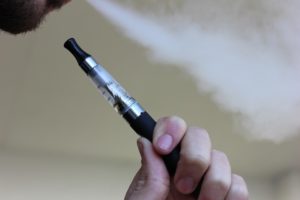What is Vaping?
Vaping is the act of haling and exhaling the aerosol, often referred to as vapor, produced by an e-cigarette or similar device.
It has become more popular among teens than regular cigarettes, especially given that vaping devices can be used for anything from flavors like mango, mint or tutti – frutti, to flavorings containing nicotine or THC, the chemical compound in marijuana that produces the high.
What are the Risks?
There are several risks to vaping for teens.
- Vaping is often marketed to kids, downplaying the dangers.
- Vaping chemicals used in the liquids can be more concentrated and dangerous.
- Vaping may make the transition to cigarette smoking easier in adolescence.
- Vaping may contribute to various health conditions including a type of cancer called “Popcorn Lung”. This is caused by Diacetyl, a chemical commonly found in e-cig liquid
Signs That Your Teen is Vaping
- The scent– E-cig vapor can have no odor at all, which is part of the appeal. The vapor can be flavored, so if you suddenly catch a whiff of fruit punch, bubble gum or mint — and you can find no juice containers, gum or candy wrappers — that could be a red flag.
- “Pens” that aren’t pens– E-cigs or vaporizers can look like many things. They can look like thumb drives, pens, or like a stylus. So if you spot something along these lines, take a closer look, and if there are holes on each end, you’ve probably got an e-cig in your hands.
- Copious sipping of liquids – One major ingredient in the vaporized liquid in e-cigs is propylene glycol, which is “hygroscopic” — meaning it attracts and holds water molecules from its environment, like the mouth. This can lead e-cig users to have a constant state of dry mouth, which can be alleviated by ingesting more drinks. Dry skin is another common side effect.
- Nose bleeds – The water-holding effect of e-cig vapor can also dry out the nasal passages, leading to bloody noses.
- Passing on caffeine – Some e-cig users develop a sensitivity to caffeine, and curb their caffeine intake. So if your teen is suddenly passing on the sodas and energy drinks they used to chug often, vaping may be to blame.
- Paraphenalia— Keep up to date on different devices that are entering the market so you may be aware of what they look like. For example, if you find empty blister packs and pods/cartridges in your teens room or car, odds are that they are using a JUUL vaping device.
JUUL and JUULing

One of the slang terms for vaping, known as JUULing (“jeweling”), comes from the JUUL brand device that looks more like a flash drive as opposed to an e-cigarette.
Middle schools and high schools are struggling to cope with a sudden increase in students using easily concealed vaping devices called Juul. Because they don’t produce a noticeable plume of smoke, some students use them in class. The size of the device allows for it to be used and be virtually undetected in school environments, at home and in public spaces.
The JUUL device uses a prefilled “pod” that contains the e-juice/liquid. Typically the “pods” contain a flavored nicotine but may also contain THC, the chemical compound in marijuana that produces the high.
What Can Parents Do

Make it clear to your son or daughter that you don’t approve of them vaping or using e-cigarettes, no matter what. If you think your son or daughter is vaping, take a deep breath and set yourself up for success by creating a safe, open and comfortable space to start talking with your child. As angry or frustrated as you feel, keep reminding yourself to speak and listen from a place of love, support and concern. Explain to them that young people who use THC or nicotine products in any form, including e-cigarettes or vaporizers, are uniquely at risk for long-lasting effects. Because these substances affect the development of the brain’s reward system, continued use can lead to addiction (the likelihood of addiction increases considerably for those who start young), as well as other health problems.
You want your child to be as healthy as possible. Find out why vaping might be attractive to your son or daughter, and work with him or her to replace it with a healthier behavior.
Vaping Guide
This comprehensive resource will explain the culture of vaping, what the current research says, and how to have difficult conversations about vaping or juuling with your child.
Sources: Lung.org and DrugFree.org

